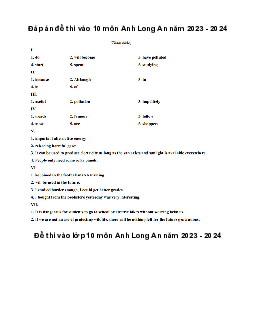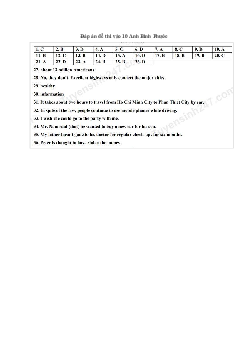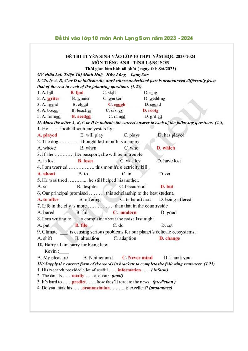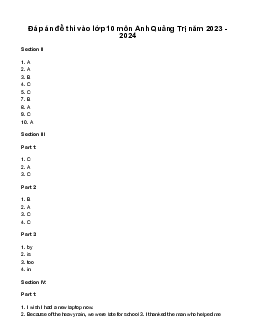





Preview text:
ĐỀ THI TIẾNG ANH VÀO LỚP 10 NĂM 2023
TỈNH BẮC GIANG CÓ ĐÁP ÁN
PHẦN I: TRẮC NGHIỆM (8.0 điểm) I. LISTENING. (2 pts)
PART 1. You will hear four short conversations. For each question, you have to choose the correct
answer A, B, or C. You will listen to the audio twice. (1pt)
Question 1. Where does Stevee live? A. Number 42. B. Number 40. C. Number 25.
Question 2. Where is Shara’s brother? A. At home. B. At the doctor’s. C. In the school library.
Question 3. How much were John’s baseball boots? A. £35 B. £29 C. £42
Question 4. What do Holly and her friends usually do on Saturday? A. Watch films. B. Go shopping. C. Go to a café.
PART 2. You will hear Jamie talking to his mum about his first day back at school after the summer
holiday. For each question, choose the correct answer A, B, or C. You will listen to the audio twice. (1pt)
Question 5. Which subject did Jamie have first? A. Biology B. Maths C. Physics
Question 6. Jamie says that his new timetable is ____. A. hard work B. interesting C. difficult to remember
Question 7. What did Jamie forget to take with him? A. His lunch. B. His football boots. C. His homework.
Question 8. What did Jamie enjoy most on his first day? A. Being in a new place. B. Seeing old friends. C. Meeting new people.
II. Choose the best answer A, B, C or D to fill the blanks from 9 to 12. (1 pt)
Children (9) ________ appear intelligent and have normal sight and hearing may nevertheless have
learning disability such as dyslexia, difficulty in reading; dysgraphia, difficulty in writing; dyscalculia,
difficulty with numbers; and auditory-memory problem that (10) ________the child from remembering
what has just been said. Considered an "invisible" (11) ___________, such learning disabilities can be
detected by alert parents before the children go to school. If the child at about thirty months is not
developing normal language skills, something is amiss. A child who cannot do puzzles or put pegs in
holes lacks perceptual-motor skills. Kindergarteners should (12) ________the ABCs. First-graders
may commonly reverse their letters, writing a d or a b, but if they are still doing this at the start of
second grade, they should be tested for learning disabilities. Proper and early treatment is essential. Question 9. A. whom B. they C. whose D. who Question 10. A. avoid B. prevent C. encourage D. help
Question 11. A. barrier B. retard C. disabled D. handicap Question 12. A. read B. remember C. recognize D. pronounce
III. Choose the best answer A, B, C or D to complete each of the following sentences. (3 pts)
Question 13. Are you worrying ____ our coming exam? ~ I am just a bit nervous, I think. A. for B. about C. with D. of
Question 14. “Would you mind if I switch off the airconditioner?” ~ “______.”
A. Oh, help yourself B. You’re welcome C. Don’t worry D. Here you are
Question 15. We’re going to help the victims ______ houses were destroyed after the earthquakes. A. which B. who C. whom D. whose
Question 16. The builders won’t cut down all the trees along this road, ______? A. do they B. would they C. will they D. are they
Question 17. This bad weather makes most kids ______. A. tired B. tiring C. tiredness D. tiredly
Question 18. He arrived home from work, had lunch and _____ before leaving for the afternoon shift. A. made a rest B. took a rest C. did a rest D. gave a rest
Question 19. Children usually prefer ______ cartoons on TV to doing homework. A. to watch B. watch C. to watching D. watching
Question 20. It was raining heavily but he decided ______ his trip to the mountains. A. set off B. setting off C. to set off D. to setting off
Question 21. “You did really well, John. Congratulations on getting the first prize!” ~ “______.”
A. It’s my pleasure B. It’s nice of you to say so C. It’s all right D. Great idea
Question 22. Unless we try harder every day, we ____ our dreams. A. won’t reach B. couldn’t reach C. don’t reach D. didn’t reach
Question 23. My close friend is hardly late for class, and ____. A. I am, too B. So am I C. I am, either D. neither am I
Question 24. Do you have ___ extra paper with you, I left mine at home. A. some B. any C. a few D. a little
IV. Choose the word whose underlined part is pronounced differently from the others. (1pt)
Question 25. A. averaged B. accomplished C. advanced D. watched
Question 26. A. clothes B. garages C. caves D. potatoes
Question 27. A. government B. guest C. gemstone D. gallery Question 28. A. nature B. volcano C. grateful D. management
V. Read the following passage and mark the letter A, B, C, or D to indicate the correct answer to
each of the questions from 29 to 32. (1pt)
Desert tundra, or cold desert, occurs on the Arctic edges of North America, Europe, and Asia.
The word tundra comes from a Finnish word tunturia, which means barren land. In the desert tundra,
the temperatures are almost always freezing, and they cause an environment in which plant life is
virtually impossible. Plant life is made impossible by two different extreme conditions, either a lack or an overabundance of water.
During at least three quarters of the year, the Arctic is frozen. The Arctic is far from the equator.
This means the sunlight reaching the soil contains less energy than at the equator. The existence of ice
rather than water for the majority of the year means that vegetation does not have enough moisture for growth to take place.
During the period of time when the temperature increases enough for ice to melt, there is
generally a large volume of water. Too much water and not enough drainage through the frozen subsoil
make it difficult for plants to grow. Despite this, about 1,700 kinds of plants grow on tundra, including
reindeer mosses, liverworts, and grasses. The 400 varieties of flowers found add a wide range of colors.
Question 29. Which of the following is the best title for the passage?
A. Where Desert Tundra is Found C. The Weather in the Arctic
B. The Effect of Desert Tundra on Plant Life
D. The Variety of Plant Life in Desert Tundra
Question 30. According to the passage, desert tundra is found______.
A. throughout North America, Europe, and Asia B. in Antarctica
C. on the Arctic borders of the northern continents D. at the North Pole
Question 31. According to the passage, what makes plant life almost impossible in areas of desert
tundra during most of the year?
A. A lack or an overabundance of water
B. Excessive water on the plants
C. The increase in temperature D. The lack of ice
Question 32. Which of following does NOT happen when the weather heats up? A. There is too much water. B. The ice melts.
C. There is not enough drainage.
D. Plants and trees grow well.
PHẦN II: TỰ LUẬN (2.0 điểm)
I.Rearrange the words and phrases into meaningful sentences. (0.5pt)
1. He/ the exhibition/ cannot/ go/ has lost/ to see/ his/ because/ he/ ticket/.
=> ______________________________________________________________________________
2. good/ Getting/ from/ results/ your studies/ comes/ developing/ from/ study habits/ good.
=> ______________________________________________________________________________
II. Finish the second sentence so that it has the same meaning as the first one. (0.5pt)
1. Although his living condition is bad, he always holds the first position in class.
=> Despite ________________________________________________________________________
2. “What are you doing in the school library now?” Mr. John asked Mary.
=> Mr. John asked Mary _____________________________________________________________
III. In about 100 words, write a paragraph about what you do in your free time. (1pt) ĐÁP ÁN
PHẦN I: TRẮC NGHIỆM (8.0 điểm)I. LISTENING. (2 pts) PART 1. (1pt)
Question 1. C. Number 25.
Question 2. A. At home. Question 3. B. £29
Question 4. A. Watch films. PART 2. (1pt) Question 5. B. Maths
Question 6. C. difficult to remember
Question 7. A. His lunch.
Question 8. C. Meeting new people. II. (1 pt) Question 9. D. who
Question 10. B. prevent
Question 11. A. barrier
Question 12. C. recognize III. (3 pts) Question 13. B. about
Question 14. A. Oh, help yourself
Question 15. D. whose
Question 16. C. will they
Question 17. A. tired
Question 18. B. took a rest
Question 19. D. watching
Question 20. C. to set off
Question 21. B. It’s nice of you to say so
Question 22. A. won’t reach
Question 23. D. neither am I Question 24. B. any IV. (1pt)
Question 25. A. averaged
Question 26. B. garages
Question 27. C. gemstone
Question 28. D. management V. (1pt)
Question 29. Which of the following is the best title for the passage?
B. The Effect of Desert Tundra on Plant Life
Question 30. C. on the Arctic borders of the northern continents
Question 31. A. A lack or an overabundance of water
Question 32. D. Plants and trees grow well.
PHẦN II: TỰ LUẬN (2.0 điểm)
I.Rearrange the words and phrases into meaningful sentences. (0.5pt)
1. He cannot go to see the exhibition because he has lost his ticket.
2. Getting good results from your studies comes from developing good studies habits.
II. Finish the second sentence so that it has the same meaning as the first one. (0.5pt)
1. Despite his bad living condition, he always holds the first position in class.
Despite the fact that his living condition is bad, he always holds the first position in class.
2. Mr. John asked Mary what she was doing in the school library then.
III. In about 100 words, write a paragraph about what you do in your free time. (1pt) Tiêu chí
Mô tả chi tiết các tiêu chí Điểm
- Đúng cấu trúc của đoạn văn, phù hợp với chủ đề: Có câu chủ đề Cấu trúc
(Topic sentence); các ý minh họa (Supporting sentences/ ideas, từ 2 Trình 0,25 điểm
supporting sentences/ ideas trở lên); và câu kết luận (Concluding bày
sentence). Viết đủ số từ theo quy định. Không xuống dòng
- Viết đúng chủ đề, các ý minh họa rõ ràng, có tính thuyết phục. 0,25 điểm Nội dung
- Viết logic, hợp lí; mạch lạc, rõ ràng 0,25 điểm
- Viết đúng cấu trúc ngữ pháp; sử dụng các liên từ hợp lý để liên kết 0,25 điểm
Ngôn ngữ các ý trong đoạn.
- Sử dụng từ vựng phù hợp, phong phú, hạn chế lặp lại từ vựng. Tổng điểm 1/1 điểm
Cách tính lỗi (trừ điểm)
- Mỗi lỗi ngữ pháp, cấu trúc câu,….: 0,1 - Mỗi lỗi từ vựng. 0,1
- Số lượng từ (+ - 30% số từ theo quy định) 0,25




